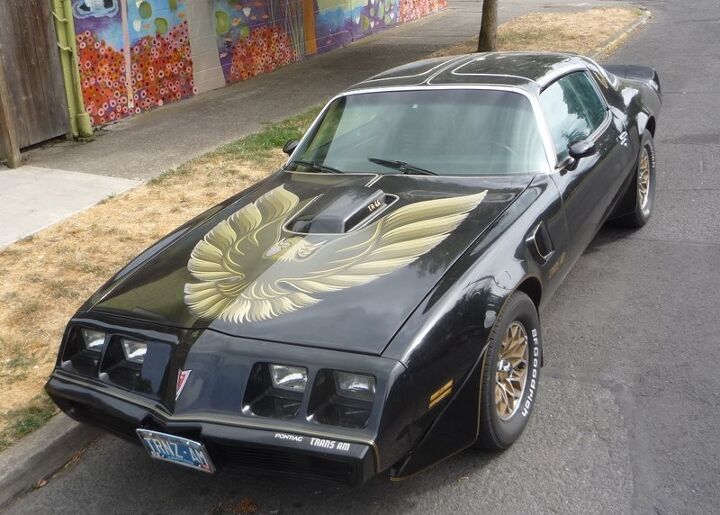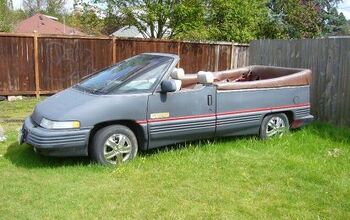Curbside Classic: 1979 Pontiac Firebird Trans Am

Instead of a “screaming chicken”, the 1979 Firebird Trans Am should have a pterodactyl on the hood. This is truly a living dinosaur, the very last direct descendant of the the original big block/hi-po pony car. Once a thriving species during the golden performance car era, it was all but wiped out by that great natural calamity, the 1974 energy crisis. Challenger, Barracuda, Mustang, Javelin; even its stablemate the Camaro Z28; by 1975 they were all extinct or in deep hibernation. Only the Trans Am hung in there, and then just by a whisker, or a feather, in this case.
But Pontiac’s risky gamble to press on against the odds had a huge payoff: not only did Trans Am sales explode by the end of the decade, but it came to symbolize the whole genre. Rarely has one car so dominated the American public’s awareness: in the second half of the seventies, the Trans Am became the icon of the American performance car, for better or for worse.
In 1972, GM had a huge internal battle going as to whether the new-for 1970 F-Body Camaro and Firebird should be scrapped by 1973, rather than invest the sums necessary to re-engineer them for the new mandated impact-absorbing bumpers being phased. Sales of the handsome coupes had been hampered by production delays, strikes and the general fall-off of the whole segment, in response to rising insurance and other factors. Ford was pulling the plug on their oversize Mustang in favor of the Pinto-based Mustang II, and Chrysler and AMC walked away from the market altogether.
GM had the Vega-based H-bodies coming for 1975, to do battle with the Mustang II and the import sporty coupes. That seemed to be where the future action was, and big-engined performance cars were out, a relic of the good old days that ended so abruptly. But the right side won, GM hung in there, and it turned out to be one of the best choices they made in that era. Americans were not all ready to embrace a future of little four-banger Shetland-pony cars. And once gas prices stabilized in 1975 and 1976, and the economy revived, GM’s decision turned out to be a gold-pinstriped mine.
The Trans Am retained its big block 455 CID V8 through 1976, long after the Camaro jettisoned both the 396 or the the 350 CID Z28. The glory years of the big Poncho engine were of course the earliest ones, before lower compression ratios and smog controls eroded its once awesome Ram Air. And the Super Duty 455 still managed a respectable 290 (net) hp despite them. A genuine terror through 1974, by 1975 the TA 455 had its wings clipped, but was still the only thing of its kind on the market.
The legend was firmly established, and it was a rip-roaring success. So much so, that Chevrolet brought the Z28 out of hibernation for 1977.5. And although it sold well enough, the Trans Am was now firmly established as a cultural icon, thanks in part to its starring role in the classic car-chase/stunt movies of the times, Smokey and the Bandit and Hooper. The Trans Am and Burt Reynolds are inextricably intertwined, reflecting the good-old boy reaction and renaissance that was taking place as an antidote to the seventies’ massive cultural changes.
Pontiac faced an uphill battle to keep the performance real in the TA, and frankly, it was mostly a losing one. That’s not surprising, given the ever-tightening emission and CAFE regs. The 455, now down to 215 hp, made its last appearance in the ’76 TA, to be supplanted by the smaller-bore 400 Pontiac as well as the Olds 403 in CA, where the emission standards were even tighter. And by 1979, the Olds 403 had taken up residence in all TAs, except for a handful of genuine Pontiac 400 engines left over from 1978, and used mostly in the 10th Anniversary edition.
But who cared if the Trans Am was powered by a 185 hp Olds 403 shared with a Vista Cruisers? The screaming chicken was still on the hood, the scoops and vents were sort-of real, and it looked like stink, even if it only went like a well-muffled fart. It was still the only game in town, if you wanted bragging rights to a sporty coupe with something big under the hood. Step right this way, you sideburned and mustachioed young (and not so young) men of America!
And did they ever, in droves. Firebird and TA sales soared during this period, and hit a phenomenal peak in 1979: some 210k Firebirds total, of which over half were TAs. And even though the Firebird was the more visible of the two, the Camaro sold in even bigger numbers. In 1979, GM moved about a half-million of these F-bodies; a mind-boggling number compared to today’s Camaro. It was the final blowout, before another energy crisis crashed the party again, in 1980-1981. Sales crashed, and by 1982, the downsized third-gen Firebird appeared with a standard 90hp 2.5 L Iron Duke four banger.
The Firebird eventually found its performance legs again in the late eighties, thanks to fuel injection, but it never recouped its old sales moxie. That 1979 number stands as the all-time high for the Firebird, by a healthy margin. And this 1979 is also the last year for the big V8 altogether in the TA; by 1980, only the smaller Pontiac 301 and Chevy 305 were available. In a last desperate attempt to keep performance in the TA, a turbo version of the 301 was developed.
Although it was rated at 210 hp, more than the Olds 403, its performance never lived up to its hype, thanks to the limitations of its crude electronics to control pre-detonation. GM’s turbo skills with Buick’s hot V6 were still a few years away. As impressive as the Turbo Trans Am sounded (in name), it was a flop; good luck finding one today.
I was happy enough to see this fairly clean but original ’79 TA roll up to the Cornucopia, a neighborhood cafe featuring the best grass-fed beef hamburgers in town. My eyes have been peeled for a good vintage TA since starting CC, and it only makes sense it would be here. I wouldn’t exactly expect a Trans Am to pull up to one of the many vegan eateries in town.

More by Paul Niedermeyer
Latest Car Reviews
Read moreLatest Product Reviews
Read moreRecent Comments
- 3-On-The-Tree Alan, I was an Apache pilot and after my second back surgery I was medically boarded off of flying status due to vibrations, climbing on and off aircraft, so I was given the choice of getting out or re-branching so I switched to Military Intel. Yes your right if you can’t perform your out doesn’t matter if your at 17 years. Dad always said your just a number, he was a retired command master chief 25 years.
- ToolGuy "Note that those vehicles are in direct competition with models Rivian sells"• I predict that we are about to hear why this statement may not be exactly true
- ToolGuy From the relevant Haynes Repair Manual:"Caution: The 4.6L models require a special tool to extract the water pump from the coolant crossover housing. This special tool is expensive and the removal procedure is difficult. Have the water pump replaced by a dealer service department or other qualified automotive repair facility if the tool is not available."One version of the tool is Lisle 14440; I paid $10.82 (less 5% discount, plus shipping).You can see why I never attempt my own maintenance or repairs. 😉
- Dave M. IMO this was the last of the solidly built MBs. Yes, they had the environmentally friendly disintegrating wiring harness, but besides that the mechanicals are pretty solid. I just bought my "forever" car (last new daily driver that'll ease me into retirement), but a 2015-16 E Class sedan is on my bucket list for future purchase. Beautiful design....
- Rochester After years of self-driving being in the news, I still don't understand the psychology behind it. Not only don't I want this, but I find the idea absurd.









































Comments
Join the conversation
I currently own a 1981 TA Nasar Edition with but 28K miles on the clock. Have had it for 10 years and still to this day love sliding in, removing the t-tops and cruising the car shows or long stretches of highway. The 49 in my screen name indicates the 301 turbos size in liters (4.9) and I have considerable experience with this and the NA mill of this time era. With a few simple tweaks and 93 octane or higher it is a pretty good performer and much better than it is given credit for. It was the performance option for 80-81 that replaced the 400 and 403 engines with 20 plus highway MPG capability and much better performance than what was available at the time. An axample I like to use is the 80-81 Mustang which used a 4.2 liter 115-120 HP V8 as it's top option in place of the 133 HP turbo 2.3 liter Pinto engine which made no torque and made no off the line power. Chrysler had nothing even close and Chevys own Corvette made due with a 305 in Calif 1980 cars and the 81 350 was down to but 190 HP! AMC was out of the game scraping there 304 after 1979 and the Camaro was using 175-190 HP 350 V8's and many 305's even. So with a properly tuned 301 turbo you could hit mid to high 15 second 1/4 mile time which was quite fast at the time. The tricks with this engine are making sure it is in proper tune, detonation, heat and fuel quality. A 13-14 second 1/4 mile 301 turbo is easily obtainable by removing some heat sources, pumping up the boost to 9-10 PSI compared to the factories often conservative 5-7 LBS, using premium gas which wasn't always available at the time this car debuted and a little carb tweaking. A fairly recent article in Hi Po Pontiac magazine had a 81 TA running mid 12's in the 1/4 without even opening up the engine! There is a lot of uncorked power in these engines but knowing how they work in critical.
Two notes: 1) My Dad had a Trans Am of, AFAICS, pretty much exactly this model some fifteen years later. Yes, a pterodactyl would have been more fitting, because it was a dinosaur about the day after it was released. 2)Nothing wrong with having a pterodactly on the hood, logically: As I understand the latest scientific discoveries, birds aren't just descendants of dinosaurs, they pretty much ARE (the last kinds of) dinosaurs.